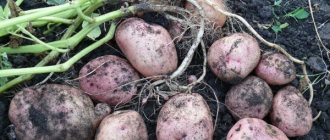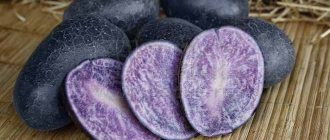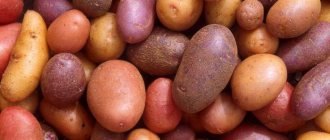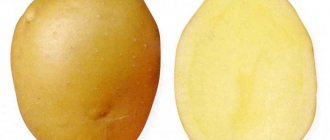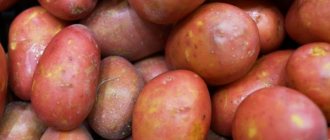Potato variety Assol
Potato Assol is an achievement of domestic selection and belongs to the population varieties. Gives a harvest in any agroclimatic zone. Due to the high yield of marketable products and early ripening, it is in great demand among potato growers and gardeners. The originator is SeDeK.
The plant has erect, slightly spreading bushes 70 - 80 cm high. The foliage is good. Leaves are medium sized, green. Flowers with a white corolla. The tubers have a beautiful elongated oval shape, aligned. The peel is smooth, light yellow. The eyes are shallow and superficial. The pulp is creamy and very tasty.
Our hero has the following characteristics:
- from the moment of full germination to harvest, 55 - 65 days pass, therefore it is classified as early ripening;
- due to early ripening, it is not affected by late blight. The originators also indicate resistance to nematodes and viral diseases;
- plastic, perfectly adapts to any unfavorable conditions, especially valued for its cold resistance;
- The potato yield is excellent. In 2007, the crop showed a record yield - 3460 g per plant, while another well-known variety, Empress, was inferior in this indicator - 3200 g per bush. On average, one nest contains up to 15 tubers, weighing about 110 grams or more;
- does not lose its taste during storage;
- purpose - table, that is, the vegetable is suitable for all types of culinary processing.
A special feature of Assol is that the crop can propagate generatively, that is, it can be grown from seeds. This technique makes it possible to obtain super-elite tubers that will be absolutely free from diseases and provide high yields for at least five years.
The seedless method is used mainly in the south. Sowing is carried out with pre-soaked and hatched seeds in the second half of April. When sown directly, the variety produces 700 g of potato sets.
The most popular, which has many advantages, is the seedling method. Sowing of seedlings is carried out in the first ten days of April. In a bright place at a temperature of 20 - 25 ° C, friendly shoots will appear in 1.5 or 2 weeks.
Hardened seedlings are planted in the ground in May - June. Replanting should be done in cloudy weather or in the evening so that the plants can adapt and not suffer from the heat. This method allows you to collect up to 866 g of sets from a bush.
From the minitubers planted next year, you will receive super-elite tubers suitable for selecting planting material for the next year.
Agricultural technology is usual for early potatoes. The variety can be grown on any type of soil, but light loamy soils with high moisture permeability are still preferred. During cultivation, it is worth carrying out prevention against the Colorado potato beetle.
The Assol variety probably has no drawbacks. But there are a lot of advantages. The main thing is its unpretentiousness to climatic conditions, which allows this potato to be grown in many regions of the country. Resistance to diseases makes caring for the crop many times easier. And its popularity among housewives is ensured by its excellent taste.
Potatoes from seeds: subtleties of growing
Any gardener who grows potatoes knows that if you do not change the planting material, the potato harvest will get worse and worse every year. Plants will be exposed to various diseases, tubers will become smaller.
Therefore, it is constantly necessary to update planting material. But even when purchasing it in a specialized store, there is no guarantee that you will buy exactly the variety you need, not infected with diseases, and grow elite-class potatoes from it.
And the seed material is quite expensive.
The solution to this issue may be to grow potatoes from seeds. What are the advantages of this method?
- Firstly, low cost: at a price of 10-30 rubles. for a bag of seeds, you will receive 30-35 full-fledged bushes with proper care.
- Secondly, the grown potatoes will be absolutely healthy; they will not contain all the diseases that accumulate in ordinary planting material.
- Thirdly, a large selection of varieties of different ripening times makes it easy to select potatoes that will meet both your needs and the climatic conditions of the area where you live.
Yes, the process of growing potatoes in this way is quite labor-intensive. But, according to numerous reviews from gardeners, it is worth it.
Where to start: choosing a variety
Early varieties: Assol, Ausonia, Velina, Ilona, Empress, Milena, Triumph, Farmer.
The highest yielder among them is the Farmer - in the first year he produces up to 809 grams. excellent potatoes, from which in a year you will get elite marketable, leveled tubers with yellow skin and yellowish pulp.
Mid-season potato varieties: Ballada, Deva, Krasa, Revenge.
Please note that seedlings of the Ilona, Triumph, and Farmer varieties do not require picking.
How to grow potatoes from seeds: technology
When growing potatoes in this way, you need to know the main difficulties you will encounter:
- Weak root system, difficulty in germination - therefore it is necessary to prepare very soft, “airy”, light soil in which the roots can easily grow and develop. Some amateur breeders even recommend carrying out the first stage of growing seedlings on wet sawdust. But most use ready-made soil bought in a store.
- Potato seedlings are very small, delicate, capricious. If they are not provided with sufficient lighting, they become very stretched. Picking and replanting must be carried out with great care so as not to ruin them.
- Potato seedlings in the early stages of growth are highly susceptible to the “black leg” disease, so it is necessary to take measures to prevent infection: for example, use trichodermin preparations, black yeast, etc.
Seed preparation
Before sowing, it is recommended to soak and germinate the seeds. Soaking is carried out for two days. You can also harden the seeds at the same time: to do this, place the containers with soaked seeds in the refrigerator overnight, and take them out in the morning and keep them at room temperature.
Then the water is drained and the seeds are germinated on a cloth in a warm place. In this case, it is better not to use gauze, since the seeds are very small, their roots will be thin, and in large cells of the gauze they will get stuck and break.
Sprouted seeds are sown in pre-prepared soil. Moreover, they do not need to be sown in furrows or holes: the seeds are placed on the surface of the ground and sprinkled on top with a thin layer of sand or very light soil. The seeds are small, it will be difficult for them to break through if the top layer of soil is too heavy and dense.
Boxes with future seedlings should be watered, covered with glass or film and put in a warm place. Monitor the soil moisture: do not allow it to dry out. Shoots appear in different ways, from 3-4 days to 2 weeks.
All this time, the seedlings should be in a warm place, without drafts.
You should not place boxes on window sills: during this period it is still too cold, cold air will come from the window, which will negatively affect both the germination of seeds and the further growth of seedlings.
Picking seedlings
When the seedlings have 2 true leaves, they need to be picked and planted in separate cups. If you are growing the Farmer, Ilona or Triumph varieties, then for them you can skip the picking stage and simply plant the seedlings in separate containers.
The main thing is not to plant thin potato sprouts directly into large cups - the root system in them will rot. It is best to use small peat cups or special plastic seedling cassettes at this stage.
Don't forget to make drainage holes in the bottom of the containers.
Picking should be done very carefully, trying not to damage the fragile roots. When replanting seedlings, they can be watered with a solution of phytosporin. Please note: to avoid blackleg disease, do not water potato seedlings with a sprinkler: water should not get on the sprouts. Watering should be carried out very carefully along the edge of the container. Always keep the soil in the cups slightly moist.
When the seedlings take root and grow after picking, they are transferred to a larger container, in which they will grow until planted in open ground. The sprouts need to be replanted together with a lump of earth, being careful not to damage the fragile root system.
Planting seedlings in open ground
Potato seedlings are planted in a permanent location when the threat of frost has passed. Usually this is the end of May. Or they insulate the bed with polyethylene or any other covering material.
They are planted in this way: prepare holes about 10 cm deep. The distance between them can be different: if you need to get a lot of small tubers, then the plants should be planted close to each other. If you want to dig up fairly large potato tubers in the fall, but in small quantities, plant the bushes at a distance of 50-70 cm from each other.
Humus is added to the holes and watered abundantly. Then the seedlings are planted: they must be deepened so that the top 3 leaves remain above the surface of the ground.
Pay special attention to the soil: the root system of the seedlings will be shallow, and in order for the bush to grow and develop well, it needs light soil. You can “lighten” it with humus, sand or old sawdust.
Further care for potatoes is usual: weeding, loosening, hilling 2-3 times per season. And, of course, the fight against the Colorado potato beetle: for some reason, it eats potatoes planted with seedlings first. And if for potatoes, which are grown in the usual way, 2-3 treatments against the beetle over the summer are enough, then seedlings, according to reviews from gardeners, have to be treated 5-6 times.
Potatoes grown this way will come in different sizes and shapes, but there will be a lot of them. And next year it will give an excellent harvest. And most importantly, the tubers will be absolutely healthy, not affected by numerous diseases that ordinary seed material accumulates.
So, despite all the difficulties of growing potatoes with seeds, it is worth updating your planting material with new elite varieties and healthy tubers.
Source: //dacha-mechta.com/kartofel-iz-semyan-tonkosti-vyrashhivaniya/
Description of potatoes
Potato Assol is the most popular early variety. The ripening period is 50-70 days, depending on growing conditions and climate zone. Gives a stable increase in yield. Early ripening makes potatoes of this variety resistant to such a dangerous disease as late blight. It has good keeping quality characteristics.
Plant characteristics
- plants are erect, semi-spreading;
- foliage and stem are bright green;
- medium-sized leaves with slightly uneven outer edges;
- the flowers are white.
Characteristics of the fetus
The tubers have an elongated, oval shape. The peel is yellowish in color with a smooth structure. The eyes are small, evenly distributed throughout the tuber.
The pulp is yellow when cut and does not lose color during heat treatment. Used for preparing various culinary delights.
Advantages and disadvantages of Lina root vegetable
Potatoes "Lana" are a medium early variety characterized by high yield. The main advantages of this type of root crop are the following:
- Suitable for both cooking and production of chips. Due to its marketable appearance, this plant variety is very popular in the market;
- The variety is not susceptible to potato canker and the action of microorganisms that contribute to the development of late blight. However, the golden nematode poses a danger to the plant;
- Differs from many other varieties in good taste;
- Has an excellent presentation;
- Frost resistance, drought resistance;
- In addition, this variety does not require special care.
Disadvantages of the variety:
- High starch content – up to 18%;
- The umbilical part is strongly pressed into the tuber.
One of the highest-yielding types of root crops is “Lina” potatoes. The positive characteristics of this variety were compiled by the best specialists in the field of plant growing; the root crop is resistant to droughts and heavy rains. The peculiarity of the root vegetable is that the plant does not require special care, but has an attractive presentation: a smooth surface with small eyes, an oval shape. All fruits are practically the same size.
Advantages and disadvantages
The undoubted advantage of early Assol potatoes is their low susceptibility to late blight and the ability to grow the crop twice a season. High taste characteristics make it suitable for preparing all kinds of dishes and for use in industrial production. The variety adapts perfectly to the climate conditions of any region and is not picky about soil composition.
Assol potatoes are easy to care for and are perfectly preserved throughout the winter without loss of taste. Like all other varieties of nightshade crops, it is subject to attacks by the Colorado potato beetle. This is perhaps the only drawback.
Agricultural technology
Plants need to be looked after
You can increase productivity by following the rules of agricultural technology and providing optimal care. All varieties of potatoes are heat-loving plants, so you need to select an open area. Potatoes should be planted from north to south in order to provide the bushes with the necessary amount of vitamin D, which is produced by the sun's rays.
Assol potatoes respond well to loosening and fertilization. It is important to follow the rules of crop rotation:
- select healthy tubers for planting;
- Do not plant potatoes in the same place for several years in a row.
Soil preparation
The qualitative composition of the soil plays a significant role in the cultivation of root crops. The highest yields are observed on sandy loam soils. They begin to prepare the soil immediately after harvesting the entire crop from the garden. If it is not possible to change the area for planting, green manure plants are planted on it, which include winter crops, flax, and legumes.
In the fall, the site needs to be dug up and organic fertilizers or superphosphates applied. Cultivation is carried out to a depth of 30 cm or more. If there are too many weeds in the area, you can use herbicides. In addition to weeds, they help destroy the larvae of the Colorado potato beetle, which are buried in the soil to a depth of 50 cm in the fall. In the spring, the soil is fertilized and cultivated again. In spring, it is not recommended to use fresh mullein or bird droppings.
Seed preparation
Seeds also begin to be prepared in the fall. During harvesting, sorting is carried out, whole, even root crops are selected for seeds, some are left for food, and the rest for reserve. To ensure good shelf life and protect against rodents, potatoes should be greened. If weather conditions permit, root vegetables are laid out in an open area for 2 days. When it is not possible to leave vegetables outside, they are stored in a well-lit room for 7 days.
In spring, seeds are germinated using any convenient method. Potatoes can be propagated by tubers, seedlings, or collected seeds during the formation of berries on the bushes. Collecting seeds from bushes is quite difficult, and this activity also requires certain breeding knowledge. Propagation by seedlings can increase productivity by 30-40%. To do this, after sprouting the potatoes, the sprouts are removed and planted in boxes.
Landing
Planting depth depends on the soil
The description of the variety makes it possible to understand that the method of planting potatoes is determined depending on the type of soil. The shovel fit is considered universal and most commonly used. The depth of planting seeds on heavy soils is no more than 5 cm, on light soils - 12 cm. Leave 40 cm between holes, 60-70 cm between rows.
Assol potatoes should be planted when the soil warms up to 10 ℃. At the planting stage, you need to apply nitrogen and potassium fertilizers. These are the minerals that plants need for optimal development. To prevent the appearance of pests, place onion peels in each hole. Instead of potassium solutions, you can use wood ash.
High-quality care ensures a good harvest. Caring for potatoes is determined by a whole range of measures. Water the potatoes with Assol as needed. In regions with arid climates, watering is carried out every 10 days, water is poured carefully under the bushes.
Harvesting
Harvesting times will depend on growing conditions and climate. They begin digging Assol potatoes when the tops begin to turn yellow. First, dig up 1 bush and check the hardness of the peel. 10 days before harvesting potatoes, all tops are cut off. Within a week, the peel becomes tougher, and the root vegetables themselves acquire that unique taste for which farmers value them so much. In addition, cutting the tops allows you to avoid infection with many diseases, because most of the pathogenic microorganisms are found on greenery.
The tops should not be left on the site; it is better to feed them to pets. Potatoes are sorted directly from the garden. After digging it up, it is left in the sun for several hours. It is important to remember that after being in direct sunlight for more than 2 hours, solanine begins to be produced in root vegetables. Then the tubers are moved under a canopy for 2 weeks, gradually reducing the air temperature to 2-4℃.
Do not forget that in the vegetable storage room, before storing, you need to disinfect the floor, walls, shelves and stairs. The cellar must be equipped with basic ventilation, as well as a thermometer and humidity meter. A decrease or increase in one of the indicators leads to damage to the crop and rapid germination of seed potatoes.
Diseases and pests
The early potato variety Assol is characterized by high resistance to all kinds of diseases. But, you should not neglect disinfecting the tubers before planting, especially if you plan to plant potatoes twice a season. Preventive spraying with systemic fungicides is also carried out until the end of flowering.
A malicious pest of potato plantings is the Colorado potato beetle. Adult beetles and larvae can remain in the ground all winter. If the females managed to mate in the fall, then in the spring they will begin to lay eggs on young shoots. For the prevention and destruction of the Colorado potato beetle, the following drugs are most often used: Regent, Colorado, Hurricane, Prestige.
If there are not many pests, it is better to collect them manually. In addition, many farmers use a solution from the beetles themselves to spray the bushes. Pests accumulate the poison solanine. Insects are collected in a jar and infused in water for a week, then the resulting liquid is diluted with water 1:1.
Description of the variety
The manufacturer of Assol potato seed material is a well-known and well-established company in the market . An early variety that demonstrates high productivity regardless of weather conditions and climatic zone.
The bushes are erect, semi-spreading. Potato tubers are uniform in shape and size, elongated-oval. The skin of the potato is smooth, light, with superficial eyes. The pulp of the tubers is light yellow, closer to cream color, slightly boiling.
Potato "Assol" has complex resistance to diseases such as late blight and nematode, as well as viral infections. The description of the variety indicates the excellent adaptability of this potato to almost any unfavorable conditions. The ripening period of this early ripening variety varies between 70-90 days.
Mid-early and mid-ripening varieties
These varieties are more popular among gardeners. They have good taste. They can be stored for a long time. They produce a large number of tubers.
Agatha
Agatha
Low plant. The potato is yellow outside and inside. The tubers are large - on average 120 g. From one bush you can collect up to 15 pieces. The amount of starch is on average 13%.
Productivity – 25 t/ha. Resistant to many diseases: late blight, cancer, fusarium.
Fun
Fun
Ukrainian variety. Has good taste. Tall. Potatoes weighing up to 120 g. Pink outside, white inside. Starch content – 14%.
High-yielding – up to 40 t/ha. Can be transported over long distances.
Irbitsky
Irbitsky
Variety of Russian selection. Productivity – 25 – 40 t/ha. Not picky about soil. Drought resistant. Resistant to late blight, cancer, nematode.
Lily
Lily
Belarusian variety. Large tubers - up to 200 g. Up to 15 pieces under one bush. Contains up to 17.5% starch. Color – straw. Under favorable conditions, up to 40 t/ha can be harvested.
Doesn't turn black when cooked.
Breeze
Breeze
It was bred by Belarusian breeders. High-yielding – 60 t/ha. Medium height. Tuber weight – up to 120 g. Color – yellow. The flowers are purple. The average amount of starch is 14%.
This type of potato can not only be fried, but even frozen.
Sineglazka
Sineglazka
Does not require maintenance. Stores well. The tuber is white inside, gray outside. High-yielding – 50 t/ha. Starch content – 15%. Resistant to nematode, scab, cancer.
Aurora
Aurora
Tall. Productivity – 21 – 38 t/ha. Tubers are brown. The inside is cream colored. On average, one plant produces 13 pieces. The weight of one is up to 130 g.
The average starch content is 15%. It has excellent gastronomic qualities.
Manifesto
Manifesto
Belarusian variety. Medium height. The flowers are painted lilac. The tuber is pink. The pulp is amber. The weight of one potato reaches up to 145 g.
The average starch content is 13%. Productivity – 16.5 – 34 t/year. Can be stored for up to 6 months. Not crumbly.
Apple tree: description of the 25 best varieties with reviews from gardeners about them
Timing and features of planting
“Assol” potatoes should be planted in fertile and light soil, which is heated to +8-10 C. When planting, it is recommended to follow the following agricultural technology requirements:
- it is advisable to fertilize the soil for planting in the fall, improving its qualitative composition with the help of humus;
- For each square meter of planting area, it is recommended to add approximately 10 liters of well-rotted manure;
- if there is acidic soil on the planting site, it is necessary to carry out high-quality liming in the fall;
- for planting in order to obtain a high-quality and high yield, it is recommended to use good varietal seed material;
- potatoes are responsive to the application of fertilizers containing magnesium, nitrogen, potassium, sulfur, phosphorus, iron, magnesium at the planting stage;
- to create planting rows, it is best to use a stretched cord, leaving a distance between rows of 70 cm, and between holes approximately 30 cm;
- You need to add a handful of high-quality humus to the hole, and then lay the tuber with the sprouts facing up.
After planting several rows of potatoes, it is recommended to carefully level the area with a rake. It is very important not to thicken potato plantings, as this can negatively affect the yield and reduce the quality of the resulting crop.
Rules of care
Potatoes of the “Assol” variety show high yields if agricultural techniques are followed and competent, timely care is carried out:
- approximately ten days or two weeks after planting the tubers, weeding should be done, followed by hilling or loosening the row spacing;
- three weeks after emergence, it is recommended to carry out preventive spraying of potato tops against late blight and the Colorado potato beetle;
- if there is an insignificant number of pests such as the Colorado potato beetle on the plantings, it is advisable to replace the use of chemicals with manual collection of parasites;
- during drought, irrigation measures should be carried out, filling the depressions between the rows with water;
- In case of dry soil, watering is carried out at least three times a month using a large amount of water.
Further care of potato plantings consists of several fertilizing with slurry or bird droppings, weeding and timely hilling of plants.
Harvesting is the most labor-intensive job in potato farming. The volume of the harvest and the shelf life of tubers during storage largely depend on the quality of potato harvesting.

